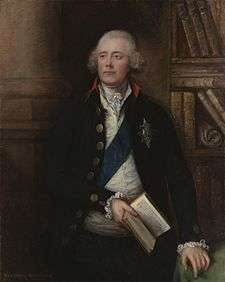George Nugent-Temple-Grenville, 1st Marquess of Buckingham
| The Most Honourable The Marquess of Buckingham KG KP PC | |
|---|---|
 | |
| Secretary of State for Foreign Affairs | |
|
In office 19 December 1783 – 23 December 1783 | |
| Prime Minister | William Pitt |
| Preceded by | Charles James Fox |
| Succeeded by | Marquess of Carmarthen |
| Lord Lieutenant of Ireland | |
|
In office 27 October 1787 – 24 October 1789 | |
| Prime Minister | William Pitt |
| Preceded by | The Duke of Rutland |
| Succeeded by | The Earl of Westmorland |
| Personal details | |
| Alma mater | Christ Church, Oxford |
George Nugent-Temple-Grenville, 1st Marquess of Buckingham, KG, KP, PC (17 June 1753 – 11 February 1813), known as The 3rd Earl Temple between 1779 and 1784, was a British statesman.
Background and early life
Grenville was the eldest son of George Grenville, Prime Minister of Great Britain, and his wife Elizabeth Wyndham, daughter of Sir William Wyndham, 3rd Baronet and was born on 17 June 1753. He was the nephew of Richard Grenville-Temple, 2nd Earl Temple, and the elder brother of Thomas Grenville and of William Grenville, 1st Baron Grenville, also Prime Minister of Great Britain. In 1764, he was appointed a Teller of the Exchequer. He was educated at Eton College from 1764 to 1770 and matriculated at Christ Church, Oxford in 1770. He succeeded his father on 13 November 1770. In 1774 he undertook a Grand Tour through Italy and Austria. In 1775, he married the Hon. Mary Nugent, daughter of the 1st Viscount Clare (later the 1st Earl Nugent). [1]
Political career


Grenville was returned as Member of Parliament for Buckinghamshire at the 1774 general election. In the House of Commons he emerged as a sharp critic of the American policy of Lord North. In September 1779, he succeeded his uncle as Earl Temple and moved to the House of Lords.[1]
Grenville also took the additional family names Nugent and Temple by Royal Warrant issued on 4 December[3] making the compound family name Nugent-Temple-Grenville. In 1782, Lord Temple was appointed Lord Lieutenant of Buckinghamshire and in July 1782, he became a member of the Privy Council and Lord Lieutenant of Ireland in the Ministry of Lord Shelburne. He was instrumental in the enactment of the Renunciation Act of 1783, which supplemented the legislative independence granted to Ireland in 1782. As Lord Lieutenant of Ireland, and by Royal Warrant, he created the Order of St Patrick in February 1783, with himself as the first Grand Master. He left Ireland in 1783 and again turned his attention to English politics. He enjoyed the confidence of King George III, and having opposed Fox's East India Bill, he was authorised by the King to say that "whoever voted for the India Bill was not only not his friend, but would be considered by him as an enemy", a message which ensured the defeat of the Bill. He was appointed a Secretary of State when the younger Pitt (his father's sister's son) formed his ministry in December 1783, but resigned only three days later.
In December 1784, Lord Temple was created Marquess of Buckingham. In November 1787, he was again appointed Lord Lieutenant of Ireland, this time under Pitt, but his second tenure of this office proved less successful than the first. Grattan denounced him for extravagance; the Irish Houses of Parliament censured him for refusing to transmit to England an address calling upon the Prince of Wales to assume the regency; and he could only maintain his position by resorting to bribery on a large scale. When his father-in-law died in 1788, Lord Buckingham succeeded him as 2nd Earl Nugent. However, since he already held the higher rank of Marquess, he was never known by this title. Having become very unpopular, he resigned his office in September 1789.
Later years
Lord Buckingham subsequently took very little part in politics, although he spoke in favour of the Act of Union of 1800. His wife died in 1812 and he died on 11 February 1813 at his residence, Stowe in Buckinghamshire. He was buried at his ancestral Wotton. He left two sons: The 1st Duke of Buckingham and Chandos and The 2nd Baron Nugent.
Styles from birth to death
- George Grenville, Esq. (1753–1774)
- George Grenville, Esq., MP (1774–1779)
- The Rt Hon. The Earl Temple (1779–1782)
- The Rt Hon. The Earl Temple, PC (1782–1784)
- The Most Hon. The Marquess of Buckingham, PC (1784–1786)
- The Most Hon. The Marquess of Buckingham, KG, PC (1786–1813)
See also
References

- 1 2 "GRENVILLE, George (1753-1813)". History of Parliament Online. Retrieved 9 October 2017.
- ↑ Casey, Christine (2005). The Buildings of Ireland: Dublin. New Haven: Yale University Press. p. 622. ISBN 978-0-300-10923-8.
- ↑ "No. 12036". The London Gazette. 30 November 1779. p. 1.
External links
- Hansard 1803–2005: contributions in Parliament by the Marquess of Buckingham
.svg.png)